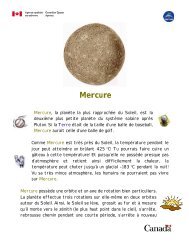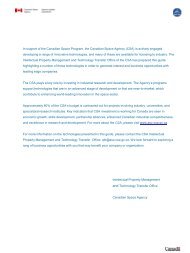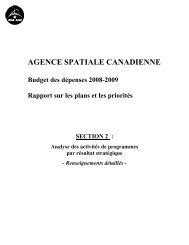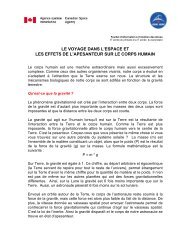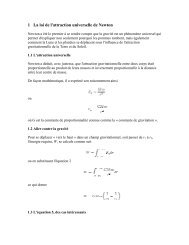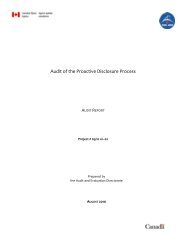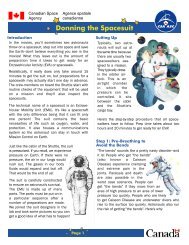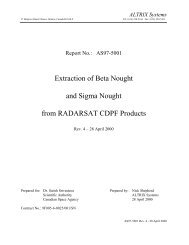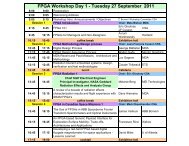PDF version of COSPAR - Space Science Research in Canada Report
PDF version of COSPAR - Space Science Research in Canada Report
PDF version of COSPAR - Space Science Research in Canada Report
You also want an ePaper? Increase the reach of your titles
YUMPU automatically turns print PDFs into web optimized ePapers that Google loves.
The amount <strong>of</strong> data generated by the network will be stagger<strong>in</strong>g. “Collect<strong>in</strong>g andstor<strong>in</strong>g all that data is no small th<strong>in</strong>g,” said Manuel. “It has required a lot <strong>of</strong>technological development.” Although data will be transmitted from the<strong>in</strong>struments to various university groups, the University <strong>of</strong> Alberta has beencontracted to ma<strong>in</strong>ta<strong>in</strong> a central repository and share the <strong>in</strong>formation with the rest<strong>of</strong> the world.The University <strong>of</strong> Alberta also has facility that runs computer models <strong>of</strong> theEarth’s magnetosphere. The CGSM data will be used to improve these modelsand make them as realistic as possible so they can eventually be used to predictspace weather events. Models are already used to forecast weather and climateon Earth, but “at the moment, it’s impossible to run the magnetosphere on acomputer like the ones used for weather forecast<strong>in</strong>g,” said Manuel. “Themagnetosphere is really complex to simulate.”However, he said it might be possible to l<strong>in</strong>k a series <strong>of</strong> computers from aroundthe world to evaluate the threat posed by someth<strong>in</strong>g like a coronal mass ejectionif it is detected by the monitor<strong>in</strong>g network a few days before the disturbancearrives on Earth’s doorstep.OSIRISThey said it couldn’t be done.Even after a team <strong>of</strong> Canadian researchers did it, the scientific community stillsaid it couldn’t be done. “It took us four years before people stood back and said,that’s the way we have to do it,” recalls Ted Llewellyn, emeritus pr<strong>of</strong>essor <strong>of</strong>eng<strong>in</strong>eer<strong>in</strong>g physics at the University <strong>of</strong> Saskatchewan.He is referr<strong>in</strong>g to a technique known as atmospheric tomography—a method helikens to tak<strong>in</strong>g a CAT scan <strong>of</strong> the atmosphere to reveal previously unknownaspects <strong>of</strong> its three-dimensional structure. It is be<strong>in</strong>g used by a Canadian-built<strong>in</strong>strument called OSIRIS (Optical Spectrograph and InfraRed Imager System) tomap the ozone layer <strong>in</strong> the upper atmosphere that protects the Earth’s surfacefrom the sun’s biologically damag<strong>in</strong>g ultraviolet radiation.Llewellyn, who is the pr<strong>in</strong>cipal <strong>in</strong>vestigator on the OSIRIS project, said it is theonly <strong>in</strong>strument capable <strong>of</strong> do<strong>in</strong>g atmospheric tomography at present. Orbit<strong>in</strong>gthe Earth aboard the Swedish satellite Od<strong>in</strong>, its ma<strong>in</strong> task is to produce globalvertical pr<strong>of</strong>ile maps <strong>of</strong> the ozone layer. In one day it can produce a height pr<strong>of</strong>ilethat would take a month to create us<strong>in</strong>g other techniques.58



